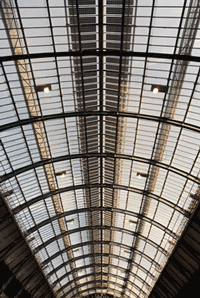New roof unveiled to give a glimpse into the future at King’s Cross
Posted: 19 September 2011 | | No comments yet
For the first time in half a century, passengers can pass through the concourse at King’s Cross station bathed in natural daylight…


For the first time in half a century, passengers can pass through the concourse at King’s Cross station bathed in natural daylight after the first section of the new roof was unveiled.
For the first time in half a century, passengers can pass through the concourse at King’s Cross station bathed in natural daylight after the first section of the new roof was unveiled.


For the first time in half a century, passengers can pass through the concourse at King’s Cross station bathed in natural daylight after the first section of the new roof was unveiled.
As part of an extensive six-year redevelopment of King’s Cross station, the 270m-long iron and glass roof above platforms 1 to 8 is being completely refurbished. Once complete, 7,500 clear glass panels and over 1,400 photovoltaic panels, which will reduce the station’s carbon footprint by 10%, will have replaced the yellowing fibreglass which was installed in the 1970s, creating a better environment for passengers.
Ian Fry, King’s Cross programme director, Network Rail said “The new roof is an important part of our plans to transform King’s Cross station. The glass panels will make the station brighter, more environmentally-friendly and a better place for passengers to be.
“We always knew accessing the roof without any impact on passengers or train services would be a huge challenge, but it’s one we rose to, and it is great that passengers can start to see the benefits. ”
A small number of skilled workers slid 130 tonnes of scaffolding 80m along the length of the roof to shield passengers during the next phase of work. Technology used to keep cars running safely on roller-coasters has been adapted and evolved by the project team, to keep the innovative curved structure safely resting on two small beams.
Grit blasters, firing at over 450mph, stripped layers of paint from the ironwork before repainting and carrying out any minor repairs. In some places 32 different coats had been applied over the years until it was a centimetre thick and any detailing in the intricate ironwork was lost.
The roof is Grade I listed and consequently, English Heritage and conservation planners have been closely involved in all aspects of the restoration, which combines traditional materials and techniques with 21st century engineering. Eighty specialists have worked on the roof for over two years, including lead workers, conservation masons and roof glaziers.
More sections of the roof will be revealed later in the month, with the entire length completing in 2011.



